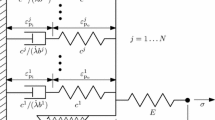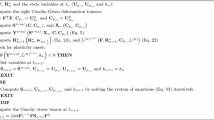Abstract
In this work, three distinct return mapping algorithms are presented and analyzed in detail: (i) a semi-explicit algorithm that accounts for the sub-incrementation technique, which reduces to (ii) a fully-explicit algorithm and, finally, (iii) a semi-implicit algorithm,. In order to describe the complex anisotropic behaviour of some metals, such as aluminium alloys, two non-quadratic anisotropic yield criteria were implemented: the Yld91 and Yld2004-18p. The performance of the developed algorithms is inferred in a series of sheet metal forming benchmarks and the quality of the results is assessed when compared to experimental results presented in the literature. The numerical simulations show that the semi-implicit algorithm is quite efficient with the von Mises yield criterion. However, when anisotropy is taken into account, the algorithm requires several iterations to return the stresses to the yield surface, particularly when the stresses are located at corner regions of that surface. The semi-explicit algorithm proved to be the most robust and efficient algorithm with anisotropic yield criteria. The good agreement between the experimental data and the obtained numerical results demonstrate the high efficiency of the presented algorithms and the ability of the anisotropic criteria to predict the material’s complex anisotropic behaviour.
















Similar content being viewed by others
References
Hill R (1948) A theory of the yielding and plastic flow of anisotropic metals. Math Phys Sci 193:281–297
von Mises RV (1913) Mechanik der fasten korper in plastisch deformablen zustand. Gottinger Nachrichten, Germany, pp 582–592
Mellor PB, Parmer A (1978) Plasticity of sheet metal forming. In: Koistinen DP, Wang NM (eds) Mechanics of sheet metal forming. Plenum Press, New York, pp 55–74
Hill R (1979) Theoretical plasticity of textured aggregates. Math Proc Camb Soc 85:179–191
Hill R (1990) Constitutive modelling of orthotropic plasticity in sheet metals. J Mech Phys Solids 38:405–417
Hill R (1993) A user-friendly theory of orthotropic plasticity in sheet metals. Int J Mech Sci 35:19–25
Barlat F, Lege DJ, Brem JC (1991) A six-component yield function for anisotropic materials. Int J Plast 7:693–712
Karafillis AP, Boyce MC (1993) A general anisotropic yield criterion using bounds and a transformation weighting tensor. J Mech Phys Solids 41:1859–1886
Barlat F, Brem JC, Yoon JW, Chung K, Dick RE, Lege DJ, Pourboghrat F, Choi SH, Chu E (2003) Plane stress yield function for aluminum alloy sheets. Part 1: theory. Int J Plast 19:1297–1319
Barlat F, Aretz H, Yoon JW, Karabin ME, Brem JC, Dick RE (2005) Linear transformation-based anisotropic yield functions. Int J Plast 21:1009–1039
Yoon JW, Barlat F, Dick RE, Karabin ME (2006) Prediction of six or eight ears in a drawn cup based on a new anisotropic yield function. Int J Plast 22:174–193
Banabic D, Balan T, Comsa DS (2000) A new yield criterion for orthotropic sheet metals under plane-stress conditions. In: Banabic D (ed) 7th Cold Metal Forming Conference. Cluj Napoca, Roménia, pp 217–224
Banabic D, Kuwabara T, Balan T, Comsa DS, Julean D (2003) Non-quadratic yield criterion for orthotropic sheet metals under plane-stress conditions. Int J Mech Sci 45:797–811
Banabic D, Aretz H, Comsa DS, Paraianu L (2005) An improved analytical description of orthotropy in metallic sheets. Int J Plast 21:493–512
Bron F, Besson J (2004) A yield function for anisotropic materials. Application to aluminum alloys. Int J Plast 20:937–963
Cazacu O, Barlat F (2001) Generalization of Drucker’s yield criterion to orthotropy. Math Mech Solids 6:613–630
Aretz H, Barlat F (2012) Unconditionally convex yield functions for sheet metal forming based on linear stress deviator transformation. Key Eng Mat 504–506:667–672
Habraken AM (2004) Modelling the plastic anisotropy of metals. Arch Comput Method Eng 11:3–96
Barlat F, Chung K (1993) Anisotropic potentials for plastically deformation metals. Model Simul Mater Sci Eng 1:403–416
Barlat F, Chung K, Richmond O (1993) Strain rate potential for metals and its application to minimum plastic work path calculations. Int J Plast 9:51–63
Barlat F, Chung K (2005) Anisotropic strain rate potential for aluminum alloy plasticity. In: Banabic D (ed) Proc. 8th ESAFORM Conference on Material Forming. The Publishing House of the Romanian Academy, Cluj-Napoca, pp 415–418
Kim JH, Lee M, Barlat F, Wagoner RH, Chung K (2008) An elasto-plastic constitutive model with plastic strain rate potentials for anisotropic cubic metals. Int J Plast 24:2298–2334
Rabahallah M, Balan T, Bouvier S, Teodosiu C (2009) Time-integration scheme for elastoplastic models based on anisotropic strain rate potentials. Int J Numer Meth Eng 80:381–402
Cazacu O, Ionescu IR, Yoon JW (2010) Orthotropic strain rate potential for the description of anisotropy in tension and compression of metals. Int J Plast 26:887–904
Chung K, Lee SY, Barlat F, Keum YT, Park JM (1996) Finite element simulation of sheet metal forming based on a planar anisotropic strain-rate potential. Int J Plast 12:93–115
Hosford WF (1966) Texture strengthening. Met Eng Q 6:13–19
Liu C, Huang Y, Stout MG (1997) On the asymmetric yield surface of plastically orthotropic materials: a phenomenological study. Acta Metall 45:2397–2406
Cazacu O, Barlat F (2004) A criterion for description of anisotropy and yield differential effects in pressure-insensitive metals. Int J Plast 20:2027–2045
Cazacu O, Plunkett B, Barlat F (2006) Orthotropic yield criterion for hexagonal closed packed metals. Int J Plast 22:1171–1194
Nixon ME, Cazacu O, Lebensohn RA (2010) Anisotropic response of high-purity alpha-titanium: experimental characterization and constitutive modeling. Int J Plast 26:516–532
Plunkett B, Cazacu O, Barlat F (2008) Orthotropic yield criteria for description of the anisotropy in tension and compression of sheet metals. Int J Plast 24:847–866
Stoughton TB (2002) A non-associated flow rule for sheet metal forming. Int J Plast 18:687–714
Stoughton TB, Yoon JW (2004) A pressure-sensitive yield criterion under a non-associated flow rule for sheet metal forming. Int J Plast 20:705–731
Arghavani J, Auricchio F, Naghdabadi R (2011) A finite strain kinematic hardening constitutive model based on Hencky strain: general framework, solution algorithm and application to shape memory alloys. Int J Plast 27:940–961
Taherizadeh A, Green DE, Ghaei A, Yoon JW (2010) A non-associated constitutive model with mixed iso-kinematic hardening for finite element simulation of sheet metal formig. Int J Plast 26:288–309
Taherizadeh A, Green DE, Yoon JW (2011) Evaluation of advanced anisotropic models with mixed hardening for general associated and non-associated flow metal plasticity. Int J Plast 27:1781–1802
Gao X, Zhang T, Zhou J, Graham M, Hayden M, Roe C (2011) On stress-state dependent plasticity modeling: significance of the hydrostatic stress, the third invariant of stress deviator and the non-associated flow rule. Int J Plast 27:217–231
Wilkins ML (1964) Calculation of elastic–plastic flow, vol 3. Academic Press
Ortiz M, Pinsky PM (1981) Global analysis methods for the solution of elastoplastic and viscoplastic dynamic problems. Dept. Civil Eng. University of California, Berkley, EUA
Ortiz M, Pinsky PM, Taylor RL (1983) Operator split methods for the numerical solution of the elastoplastic dynamic problem. Comput Method Appl Mech Eng 39:137–157
Ortiz M, Simo JC (1986) An analysis of a new class of integration algorithms for elastoplastic relations. Int J Numer Method Eng 23:353–366
Yoon JW, Yang DY, Chung K (1999) Elasto-plastic finite element method based on incremental deformation theory and continuum based shell elements for planar anisotropic sheet materials. Comput Method Appl Mech Eng 174:23–56
Sousa RJA, Yoon JW, Cardoso RPR, Valente RA, Gracio JJ (2007) On the use of a reduced enhanced solid-shell (RESS) element for sheet forming simulations. Int J Plast 23:490–515
Banabic D, Barlat F, Cazacu O, Kuwabara T (2010) Advances in anisotropy and formability. Int J Mater Form 3:165–189
Cardoso RPR, Yoon JW (2009) Stress integration method for a nonlinear kinematic/isotropic hardening model and its characterization based on polycrytal plasticity. Int J Plast 25:1684–1710
Hinton E (1992) Introduction to nonlinear finite element analysis. NAFEMS Publications
Owen DRJ, Hinton E (1980) Finite elements in plasticity: Theory and practice. Pineridge Press Limited, Swansea
Yoon JW, Barlat F, Gracio JJ, Rauch E (2005) Anisotropic strain hardening behavior in simple shear for cube textured aluminum alloy sheets. Int J Plast 21:2426–2447
Huang J, Griffiths DV (2009) Return mapping algorithms and stress predictors for failure analysis in geomechanics. J Eng Mech 135:276–284
Yoon JW, Barlat F, Chung K, Pourboghrat F, Yang DY (2000) Earing predictions based on asymmetric nonquadratic yield function. Int J Plast 16:1075–1104
NUMISHEET'96 organizing committee (1996) In: Lee JK (ed) 3rd International Conference of NUMISHEET'96, Dearborn, Michigan, EUA
Acknowledgments
The authors acknowledge the financial support given by the grants SFRH/BD/82286/2011, PTDC/EME-TME/115876/2009 and PTDC/EME-TME/098845/2008, from the Fundação para a Ciência e a Tecnologia, Ministério da Educação e Ciência (Portugal).
Author information
Authors and Affiliations
Corresponding author
Rights and permissions
About this article
Cite this article
Grilo, T.J., Valente, R.A.F. & de Sousa, R.J.A. Assessment on the performance of distinct stress integration algorithms for complex non-quadratic anisotropic yield criteria. Int J Mater Form 7, 233–247 (2014). https://doi.org/10.1007/s12289-012-1123-6
Received:
Accepted:
Published:
Issue Date:
DOI: https://doi.org/10.1007/s12289-012-1123-6




